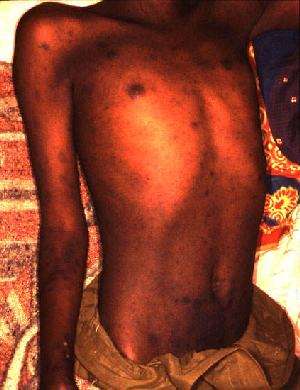Typhus
Typhus, also known as typhus fever, is a group of infectious diseases that include epidemic typhus, scrub typhus, and murine typhus.[1] Common symptoms include fever, headache, and a rash.[1] Typically these begin one to two weeks after exposure.[2]
| Typhus | |
|---|---|
| Other names | Typhus fever |
 | |
| Rash caused by epidemic typhus | |
| Specialty | Infectious disease |
| Symptoms | Fever, headache, rash[1] |
| Usual onset | 1–2 weeks after exposure[2] |
| Causes | Bacterial infection spread by parasites[1] |
| Treatment | Doxycycline[2] |
| Frequency | Rare[3] |
The diseases are caused by specific types of bacterial infection.[1] Epidemic typhus is due to Rickettsia prowazekii spread by body lice, scrub typhus is due to Orientia tsutsugamushi spread by chiggers, and murine typhus is due to Rickettsia typhi spread by fleas.[1]
Currently no vaccine is commercially available.[3][4][5] Prevention is by reducing exposure to the organisms that spread the disease.[3][4][5] Treatment is with the antibiotic doxycycline.[2] Epidemic typhus generally occurs in outbreaks when poor sanitary conditions and crowding are present.[6] While once common, it is now rare.[3] Scrub typhus occurs in Southeast Asia, Japan, and northern Australia.[4] Murine typhus occurs in tropical and subtropical areas of the world.[5]
Typhus has been described since at least 1528 AD.[7] The name comes from the Greek tûphos (τύφος) meaning hazy, describing the state of mind of those infected.[7] While "typhoid" means "typhus-like", typhus and typhoid fever are distinct diseases caused by different types of bacteria.[8]
Signs and symptoms
These signs and symptoms refer to epidemic typhus, as it is the most important of the typhus group of diseases.[9]
Signs and symptoms begin with sudden onset of fever, and other flu-like symptoms about one to two weeks after being infected.[10] Five to 9 days after the symptoms have started, a rash typically begins on the trunk and spreads to the extremities. This rash eventually spreads over most of the body, sparing the face, palms, and soles. Signs of meningoencephalitis begin with the rash and continue into the second or third weeks. Other signs of meningoencephalitis include sensitivity to light (photophobia), altered mental status (delirium), or coma. Untreated cases are often fatal.
Causes
Multiple diseases include the word "typhus" in their descriptions.[11] Types include:
| Condition | Bacterium | Reservoir/vector | Notes |
|---|---|---|---|
| Epidemic louse-borne typhus | Rickettsia prowazekii | Body louse | When the term "typhus" is used without clarification, this is usually the condition described. Historical references to "typhus" are now generally considered to be this condition. |
| Murine typhus or "endemic typhus" | Rickettsia typhi | Fleas on rats | |
| Scrub typhus | Orientia tsutsugamushi | Harvest mites on humans or rodents | |
| Spotted fever | Rickettsia spotted fever group | Ticks | Includes Boutonneuse fever, Rocky Mountain spotted fever, Queensland tick typhus and other variants. |
Prevention
As of 2019, no vaccine is commercially available.[3][4][5] A vaccine has been in development for scrub typhus known as the scrub typhus vaccine.[12]
Treatment
The American Public Health Association recommends treatment based upon clinical findings and before culturing confirms the diagnosis.[13] Without treatment, death may occur in 10% to 60% of people with epidemic typhus, with people over age 60 having the highest risk of death. In the antibiotic era, death is uncommon if doxycycline is given. In one study of 60 people hospitalized with epidemic typhus, no one died when given doxycycline or chloramphenicol.[14] Some people also may need oxygen and intravenous fluids.
Epidemiology
According to the World Health Organization, the current death rate from typhus is about one of every 5,000,000 people per year.[15]
Only a few areas of epidemic typhus exist today. Since the late 20th century, cases have been reported in Burundi, Rwanda, Ethiopia, Algeria, and a few areas in South and Central America.[16][17][18][19]
Except for two cases, all instances of epidemic typhus in the United States have occurred east of the Mississippi River. An examination of a cluster of cases in Pennsylvania concluded the source of the infection was flying squirrels.[20] Sylvatic cycle (diseases transmitted from wild animals) epidemic typhus remains uncommon in the US. The Centers for Disease Control and Prevention have documented only 47 cases from 1976 to 2010.[21] An outbreak of flea-borne typhus was identified in downtown Los Angeles, California in October 2018 that was larger than their usual number of typhus cases.[22]
History
Middle Ages
The first reliable description of the disease appears in 1489 AD during the Spanish siege of Baza against the Moors during the War of Granada (1482–1492). These accounts include descriptions of fever; red spots over arms, back, and chest; attention deficit, progressing to delirium; and gangrenous sores and the associated smell of rotting flesh. During the siege, the Spaniards lost 3,000 men to enemy action, but an additional 17,000 died of typhus. [23]
Jail fever
In historical times, "jail fever", or "Aryotitus fever" was common in English prisons, and is believed by modern authorities to have been typhus. It often occurred when prisoners were crowded together into dark, filthy rooms where lice spread easily. Thus, "imprisonment until the next term of court" was often equivalent to a death sentence. Prisoners brought before the court sometimes infected members of the court.[24] Following the assizes held at Oxford in 1577, later deemed the Black Assize, over 300 died from gaol fever, including Sir Robert Bell, Lord Chief Baron of the Exchequer. The Black Assize of Exeter 1586 was another notable outbreak. During the Lent assizes court held at Taunton in 1730, gaol fever caused the death of the Lord Chief Baron, as well as the High Sheriff, the sergeant, and hundreds of others. During a time when persons were executed for capital offenses, more prisoners died from 'gaol fever' than were put to death by all the public executioners in the British realm. In 1759, an English authority estimated that each year, a quarter of the prisoners had died from gaol fever.[24] In London, gaol fever frequently broke out among the ill-kept prisoners of Newgate Prison and then moved into the general city population. In May 1750, the Lord Mayor of London, Sir Samuel Pennant, and a large number of court personnel were fatally infected in the courtroom of the Old Bailey, which adjoined Newgate Prison.[25]
Early modern epidemics
Epidemics occurred routinely throughout Europe from the 16th to the 19th centuries, including during the English Civil War, the Thirty Years' War, and the Napoleonic Wars.[26] Pestilence of several kinds raged among combatants and civilians in Germany and surrounding lands from 1618 to 1648. According to Joseph Patrick Byrne, "By war's end, typhus may have killed more than 10 percent of the total German population, and disease in general accounted for 90 percent of Europe's casualties."[27]
19th century
During Napoleon's retreat from Moscow in 1812, more French soldiers died of typhus than were killed by the Russians.[28]
A major epidemic occurred in Ireland between 1816 and 1819, during the famine caused by a worldwide reduction in temperature known as the Year Without a Summer. An estimated 100,000 people perished. Typhus appeared again in the late 1830s, and yet another major typhus epidemic occurred during the Great Irish Famine between 1846 and 1849. The Irish typhus spread to England, where it was sometimes called "Irish fever" and was noted for its virulence. It killed people of all social classes, as lice were endemic and inescapable, but it hit particularly hard in the lower or "unwashed" social strata.
In the United States, a typhus epidemic broke out in Philadelphia in 1837 and killed the son of Franklin Pierce (14th President of the United States) in Concord, New Hampshire, in 1843. Several epidemics occurred in Baltimore, Memphis, and Washington, DC, between 1865 and 1873. Typhus was also a significant killer during the US Civil War, although typhoid fever was the more prevalent cause of US Civil War "camp fever". Typhoid fever, caused by the bacterium Salmonella typhii (not to be confused with Salmonella enterica, the cause of salmonella food poisoning), is a completely different disease from typhus.
In Canada alone, the typhus epidemic of 1847 killed more than 20,000 people from 1847 to 1848, mainly Irish immigrants in fever sheds and other forms of quarantine, who had contracted the disease aboard the crowded coffin ships in fleeing the Great Irish Famine. Officials neither knew how to provide sufficient sanitation under conditions of the time nor understood how the disease spread.[29]
The clipper Ticonderoga was infamous for her "fever ship" voyage from Liverpool to Port Phillip carrying 795 passengers in 1852. The overcrowded ship was not designed well for passenger carrying, sanitary provisions were inadequate, and the ship's doctors were soon overwhelmed. During the voyage, 100 passengers died of what was later determined to have been typhus.
20th century
Delousing stations were established for troops on the Western Front during World War I, but the disease ravaged the armies of the Eastern Front, with over 150,000 dying in Yugoslavia alone. Fatalities were generally between 10 and 40% of those infected, and the disease was a major cause of death for those nursing the sick.
In 1922, the typhus epidemic reached its peak in Soviet territory, with some 25 to 30 million cases in Russia. Although typhus had ravaged Poland with some 4 million cases reported, efforts to stem the spread of disease in that country had largely succeeded by 1921 through the efforts of public health pioneers such as Hélène Sparrow and Rudolf Weigl.[30] In Russia during the civil war between the White and Red Armies, typhus killed 3 million people,[31][32] mainly civilians.
During World War II, many German POWs after the loss at Stalingrad died of typhus. Typhus epidemics killed those confined to POW camps, ghettos, and Nazi concentration camps who were held in unhygienic conditions. Pictures of mass graves including people who died from typhus can be seen in footage shot at Bergen-Belsen concentration camp.[33] Among thousands of prisoners in concentration camps such as Theresienstadt and Bergen-Belsen who died of typhus[33] were Anne Frank, age 15, and her sister Margot, age 19. Major epidemics in the postwar chaos of Europe were averted only by widespread use of the newly discovered DDT to kill the lice on millions of refugees and displaced persons.
The first typhus vaccine was developed by the Polish zoologist Rudolf Weigl in the interwar period.[34] Better, less-dangerous and less-expensive vaccines were developed during World War II. Since then, some epidemics have occurred in Asia, Eastern Europe, the Middle East, and parts of Africa.
 Charles Nicolle received the 1928 Nobel Prize in Medicine for his identification of lice as the transmitter of epidemic typhus.
Charles Nicolle received the 1928 Nobel Prize in Medicine for his identification of lice as the transmitter of epidemic typhus. A US soldier is demonstrating DDT hand-spraying equipment. DDT was used to control the spread of typhus-carrying lice.
A US soldier is demonstrating DDT hand-spraying equipment. DDT was used to control the spread of typhus-carrying lice. A Civilian Public Service worker distributes rat poison for typhus control in Gulfport, Mississippi, around 1945.
A Civilian Public Service worker distributes rat poison for typhus control in Gulfport, Mississippi, around 1945.
21st century
Beginning in 2018, a typhus outbreak of more than the usual number of cases has spread through Los Angeles County primarily affecting homeless people.[35] In 2019, city attorney Elizabeth Greenwood revealed that she, too, was infected with typhus as a result of a flea bite at her office in Los Angeles City Hall, which resulted in her going on medical leave.[36][37]
References
- "Typhus Fevers". www.cdc.gov. 7 March 2017. Archived from the original on 26 March 2017. Retrieved 26 March 2017.
- "Information for Health Care Providers". www.cdc.gov. 7 March 2017. Archived from the original on 27 March 2017. Retrieved 26 March 2017.
- "Epidemic Typhus". www.cdc.gov. 7 March 2017. Archived from the original on 26 March 2017. Retrieved 27 March 2017.
- "Scrub Typhus". www.cdc.gov. 7 March 2017. Archived from the original on 26 March 2017. Retrieved 26 March 2017.
- "Murine Typhus". www.cdc.gov. Archived from the original on 26 March 2017. Retrieved 26 March 2017.
- "WHO | Typhus". www.who.int. May 1997. Archived from the original on 27 March 2017. Retrieved 26 March 2017.
- Bennett, John E.; Dolin, Raphael; Blaser, Martin J. (2014). Mandell, Douglas, and Bennett's Principles and Practice of Infectious Diseases E-Book. Elsevier Health Sciences. p. 2217. ISBN 9780323263733. Archived from the original on 2017-09-10.
- Evans, Alfred S.; Brachman, Philip S. (2013). Bacterial Infections of Humans: Epidemiology and Control. Springer. p. 839. ISBN 9781461553274. Archived from the original on 2017-09-10.
- Levinson, Warren (2010). Review of Medical Microbiology and Immunology (11 ed.). McGraw Hill. ISBN 9780071700283.
- Gary R. Mullen; Lance A. Durden (27 September 2002). Medical and Veterinary Entomology. Academic Press. pp. 58–. ISBN 978-0-08-053607-1. Archived from the original on 10 September 2017.
- Eremeeva, Marina E; Gregory A Dasch. "Rickettsial (Spotted & Typhus Fevers) & Related Infections (Anaplasmosis & Ehrlichiosis)". CDC Centers for Disease Control and Prevention. Archived from the original on 17 May 2014. Retrieved 15 May 2014.
- Chattopadhyay, S; Richards, AL (2007). "Scrub typhus vaccines: past history and recent developments". Human Vaccines. 3 (3): 73–80. doi:10.4161/hv.3.3.4009. PMID 17375000.
- Heymann, David (2015). Control of communicable diseases manual : an official report of the American Public Health Association. Washington, DC: APHA Press, an imprint of the American Public Health Association. pp. 661–668. ISBN 9780875530185.
- MATOSSIAN RM, THADDEUS J, GARABEDIAN GA (1963). "Outbreak of epidemic typhus in the northern region of Saudi Arabia". Am J Trop Med Hyg. 12: 82–90. doi:10.4269/ajtmh.1963.12.82. PMID 13933690.CS1 maint: multiple names: authors list (link)
- WHO Statistical Information System (WHOSIS) Archived 2010-02-21 at the Wayback Machine
- Raoult, D (1997). "Jail fever (epidemic typhus) outbreak in Burundi". Emerg Infect Dis. 3 (3): 357–60. doi:10.3201/eid0303.970313. PMC 2627627. PMID 9284381.
- Mokrani (2004). "Reemerging threat of epidemic typhus in Algeria". J Clin Microbiol. 42 (8): 3898–900. doi:10.1128/jcm.42.8.3898-3900.2004. PMC 497610. PMID 15297561.
- "Epidemic typhus risk in Rwandan refugee camps". Wkly Epidemiol Rec. 69 (34): 259. 1994. PMID 7947074.
- Perine, PL (1992). "A clinico-epidemiological study of epidemic typhus in Africa". Clin Infect Dis. 14 (5): 1149–58. doi:10.1093/clinids/14.5.1149. PMID 1600020.
- Chapman, A (2009). "Cluster of sylvatic epidemic typhus cases associated with flying squirrels, 2004–2006". Emerg Infect Dis. 15 (7): 1005–11. doi:10.3201/eid1507.081305. PMC 2744229. PMID 19624912.
- McQuiston, JH (2010). "Brill-Zinsser disease in a patient following infection with sylvatic epidemic typhus associated with flying squirrels". Clin Infect Dis. 51 (6): 712–5. doi:10.1086/655891. PMID 20687836.
- CBS Los Angeles: "Downtown LA Hit With Outbreak Of Flea-Borne Typhus," https://losangeles.cbslocal.com/2018/10/04/downtown-la-skid-row-typhus-outbreak/, October 4, 2018.
- Zinsser, Hans (1960). Rats, Lice and History. Bantam Classic. p. 186.
- Ralph D. Smith, "Comment, Criminal Law—Arrest—The Right to Resist Unlawful Arrest", 7 NAT. RESOURCES J. 119, 122 n.16 (1967) (hereinafter Comment) (citing John Howard, The State of Prisons 6–7 (1929)) (Howard's observations are from 1773 to 1775). Copied from State v. Valentine (May 1997) 132 Wn.2d 1, 935 P.2d 1294
- Gordon, Charles The Old Bailey and Newgate Archived 2016-03-12 at the Wayback Machine pp.331–2. T. Fisher Unwin, London, 1902
- War and Pestilence Archived 2009-09-21 at the Wayback Machine. Time magazine
- Byrne, Joseph Patrick (2008). Encyclopedia of Pestilence, Pandemics, and Plagues: A—M. ABC-CLIO. p. 732. ISBN 978-0-313-34102-1. Archived from the original on 2014-01-04.
- The Historical Impact of Epidemic Typhus Archived 2009-11-14 at WebCite. Joseph M. Conlon.
- "M993X.5.1529.1 | The government inspector's office". McCord Museum. Montreal. Archived from the original on 8 April 2011. Retrieved 22 January 2012.
- Paul Weindling. International Health Organisations and Movements, 1918–1939. Cambridge University Press 1995, p. 99.
- Andrew W. Artenstein. Vaccines: A Biography. Springer 2010, p. 250
- David G. Rempel. A Mennonite Family in Tsarist Russia and the Soviet Union, 1789–1923. University of Toronto Press 2011, p. 249
- "Trials of War Criminals Before the Nurenberg Military Tribunal" (PDF). Volumn 1. US. Government Printing Office. 1949. pp. 508–511. Archived (PDF) from the original on 4 March 2016. Retrieved 19 May 2015.
- Naomi Baumslag, Murderous Medicine: Nazi Doctors, Human Experimentation, and Typhus, Greenwood Publishing Group, 2005, page 133 Archived 2014-06-27 at the Wayback Machine
- Grover, Joel; Corral, Amy. "Typhus Epidemic Worsens in Los Angeles". NBC Southern California. Retrieved 9 February 2019.
- Smith, Dakota. "L.A. City Hall, overrun with rats, might remove all carpets amid typhus fears". latimes.com.
- Service, City News. "Amid Typhus Outbreak, LA City Hall Carpets May Be Ripped Out". NBC Southern California. Retrieved 12 February 2019.
External links
| Classification | |
|---|---|
| External resources |